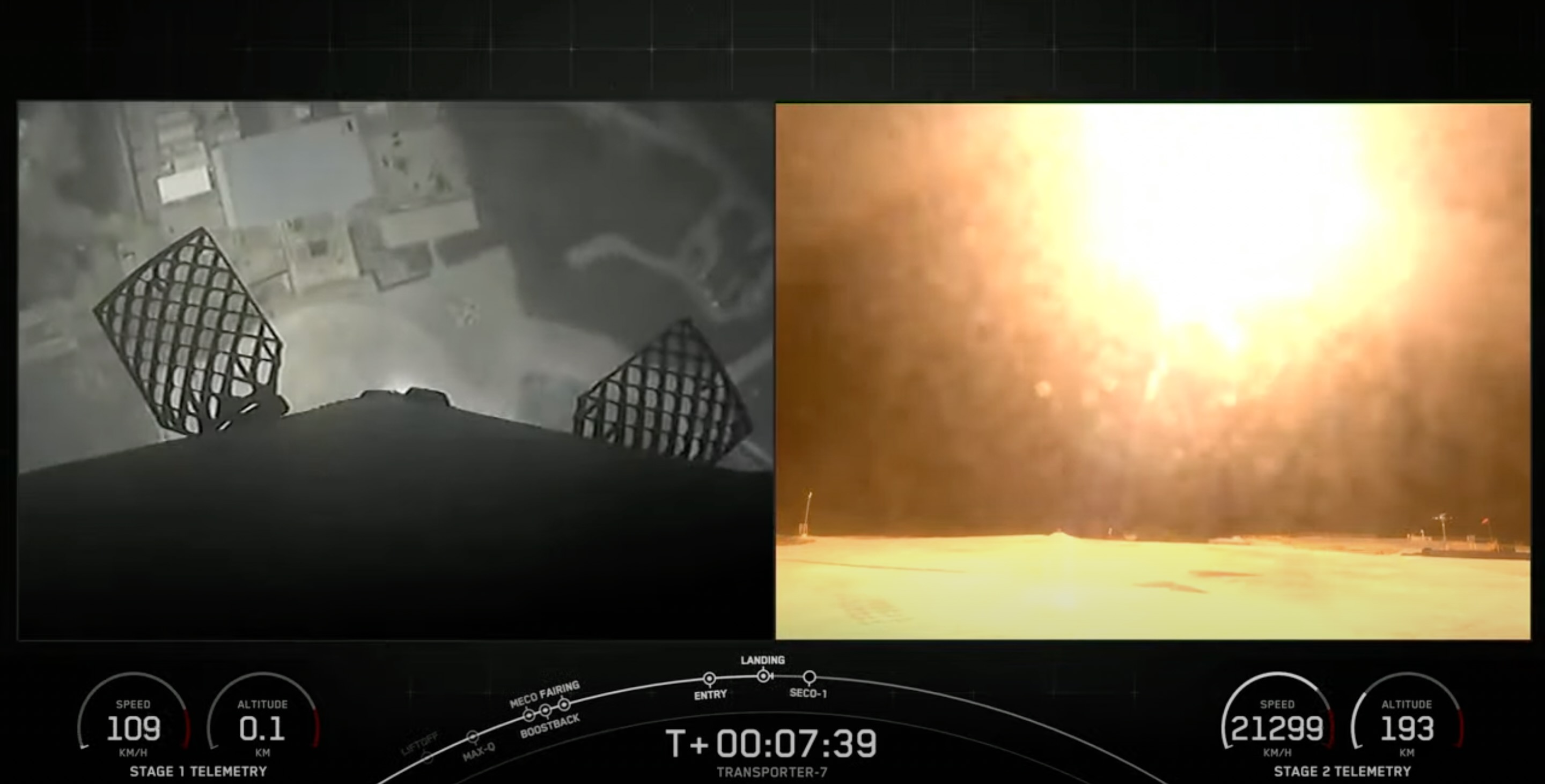SpaceX launches 51 small satellites, lands rocket back on Earth
SpaceX launched dozens of small satellites to orbit early Saturday morning (April 15) and landed the returning rocket back on Earth.
A Falcon 9 rocket topped with 51 satellites lifted off from California's Vandenberg Space Force Base at 2:48 a.m. EDT Saturday (0648 GMT; 11:48 p.m. on April 14 California time), kicking off the Transporter-7 rideshare mission.
The Falcon 9's first stage come back to Earth as planned, acing a vertical touchdown at Vandenberg about 7 minutes and 45 seconds after launch. It was the 10th launch and landing for this particular booster, according to a SpaceX mission description.
Related: 8 ways that SpaceX has transformed spaceflight
The rocket's upper stage, meanwhile, continued carrying the 51 satellites to orbit. The payloads were deployed on schedule over a roughly 95-minute span, beginning about an hour after liftoff, SpaceX confirmed via Twitter.
The payloads that launched Saturday are a diverse lot, consisting of "cubesats, microsats, hosted payloads and orbital transfer vehicles carrying spacecraft to be deployed at a later time," SpaceX wrote in the mission description.
The spacecraft will be operated by a variety of customers. The main payload, for example, is the Imece Earth-observation satellite, which was provided by the Turkish government.
Breaking space news, the latest updates on rocket launches, skywatching events and more!
Another three belong to Canadian company GHGSat, which detects greenhouse gas emissions from space. And another satellite, called Brokkr-1, will be operated by AstroForge, a California-based startup that aims to mine asteroids.
"During this mission, we will demonstrate our refinery capabilities with the goal of validating our technology and performing extractions in zero gravity," AstroForge wrote in a January blog post. "The spacecraft will launch pre-loaded with an asteroid-like material that the refinery payload will vaporize and sort into its elemental components."
As its name suggests, Transporter-7 is the seventh small-satellite rideshare mission that SpaceX has launched to date. The most recent one, Transporter-6, launched atop a Falcon 9 on Jan. 3.
Transporter-6 sent 114 satellites to orbit — quite a haul, but not a record. The mark belongs to SpaceX's Transporter-1, which launched a whopping 143 spacecraft back in January 2021.
Saturday's launch was the 24th of 2023 so far for SpaceX. Falcon 9s have flown all but one of these; the lone outlier was USSF-67, a classified mission for the U.S. Space Force launched by SpaceX's powerful Falcon Heavy rocket on Jan. 15.
We should see a lot more spaceflight action from the company in the coming weeks and months. SpaceX founder and CEO Elon Musk said last summer that the company could launch up to 100 orbital missions in 2023.
And SpaceX is currently gearing up for the first-ever orbital test flight of Starship, its next-generation spaceflight system. That landmark mission is scheduled to fly on Monday (April 17).
Transporter-7 had been scheduled to launch early Wednesday morning (April 12), but SpaceX announced on Tuesday (April 11) that it was pushing the try back by two days to allow more time for pre-launch checks and to give the weather a chance to improve. The company tried to launch early Friday morning (April 14) but scrubbed the attempt due to bad weather with about 30 seconds left on the countdown clock.
Editor's note: This story was updated at 10:35 a.m. EDT on April 12 with the correct launch date of April 14 (not April 13). It was updated again at 2:50 a.m. EDT on April 14 with news of the scrubbed launch attempt and new target date of April 15. It was updated again with news of successful launch and rocket landing at 3:10 a.m. EDT on April 15, then again at 11:10 a.m. EDT on April 15 with news of payload deployment.
Mike Wall is the author of "Out There" (Grand Central Publishing, 2018; illustrated by Karl Tate), a book about the search for alien life. Follow him on Twitter @michaeldwall. Follow us @Spacedotcom, or on Facebook and Instagram.

Michael Wall is a Senior Space Writer with Space.com and joined the team in 2010. He primarily covers exoplanets, spaceflight and military space, but has been known to dabble in the space art beat. His book about the search for alien life, "Out There," was published on Nov. 13, 2018. Before becoming a science writer, Michael worked as a herpetologist and wildlife biologist. He has a Ph.D. in evolutionary biology from the University of Sydney, Australia, a bachelor's degree from the University of Arizona, and a graduate certificate in science writing from the University of California, Santa Cruz. To find out what his latest project is, you can follow Michael on Twitter.

